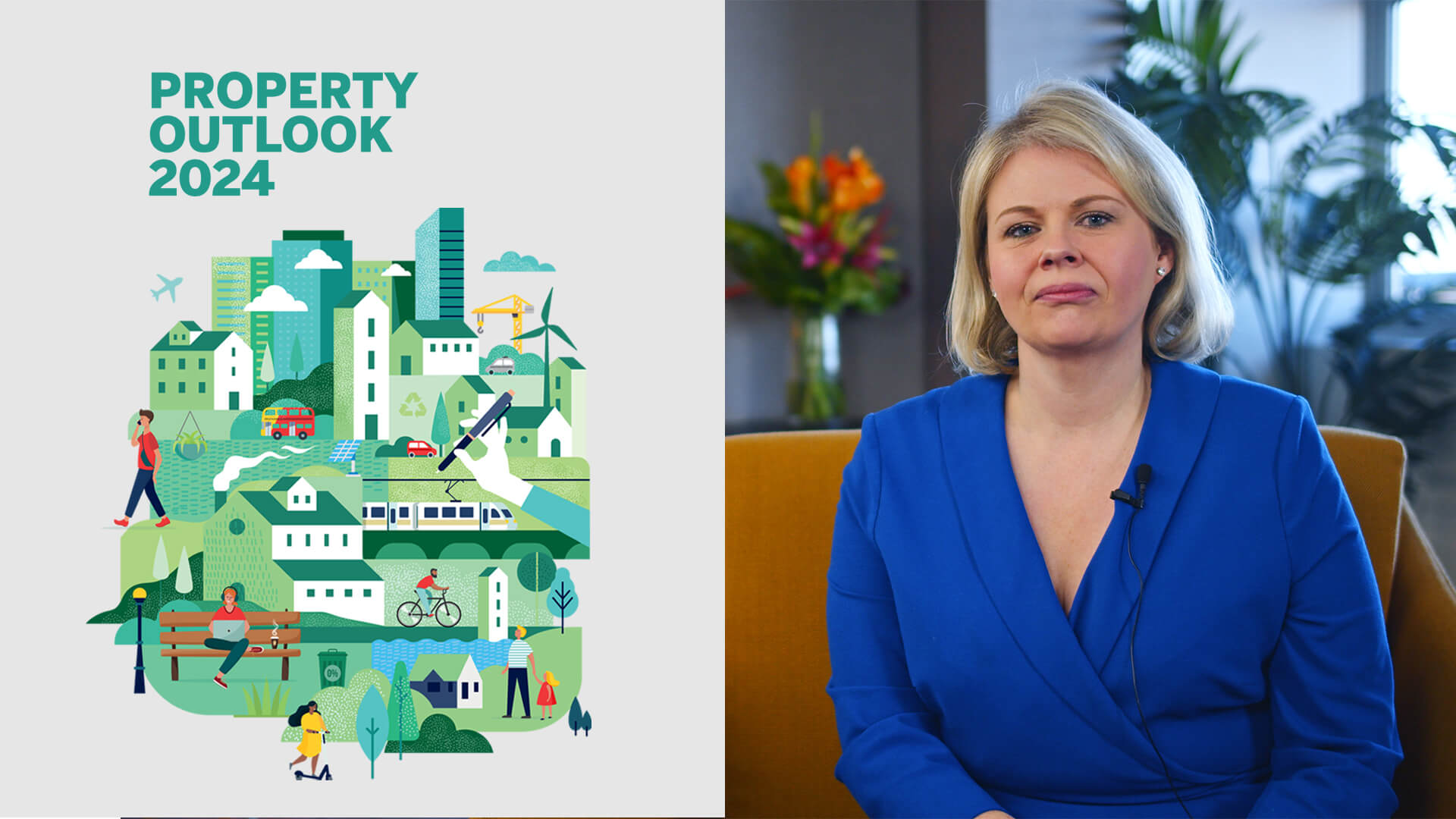Lisney Outlook 2024
9th January 2024

Lisney Outlook 2024 – Sustainability shift in Dublin’s commercial property market as ESG becomes a bigger force while residential housing supply is unlikely to improve in the short-term, with BERs being a key consideration for home buyers.
Commercial Real Estate and Investment
- Sustainability measures having a much greater influence on property market dynamics – both for occupiers and investors
- Greatest impact seen in the office investment sector where there are fears of assets becoming stranded – significant investment will be needed in the coming years to increase the BERs of buildings
- ESG to grow in importance in industrial and logistics market in 2024 with the added cost of securing relevant certifications being passed on to tenants
- Headline office vacancy rate across Dublin was almost 16% by end of 2023, the highest level since 2013 –no new buildings due past 2025 means demand for energy efficient / A rated buildings will not be met
- Property investment market will continue to be subdued for much of the year – impacted by interest rates, changing occupier trends and costs of implementing sustainability measures
- Following on from a solid 2023, activity in the licensed premises property market will remain good in Dublin and in most of the larger regional cities this year; particularly in the €1m to €3m price range
Residential
- Median price of a new home in Dublin grew by almost €40,000 in 2023, yet strong buyer sentiment continues to outstrip supply – meanwhile second-hand homes in the Capital grew by just €5,000
- Housing supply unlikely to improve in 2024 Spring selling season with delays in Probate Office impacting supply
Commercial Real Estate and Investment

High interest rates along with changing occupier trends and the costs associated with implementing sustainability measures will mean a subdued investment sector for much of 2024, according to a new report today from Lisney, Ireland’s largest independently-owned multi-disciplinary property advisory company.
For the first time ever, the industrial sector was the busiest part of the investment market last year with several large portfolios sold. The industrial occupational market was also busy and will continue to be this year, albeit with demand reverting to be more in line with pre-pandemic times.
The influence of ESG criteria on market demand will intensify. EU directives will continue to tighten to achieve a climate-neutral building stock by 2050. These directives impact a property’s life cycle – from conception and planning to construction, use, financing, and sale. Failure to meet sustainability criteria will result in a devaluation of assets. This is already beginning to materialise. Compliance with the Sustainable Finance Disclosures Regulation (SFDR) and EU Taxonomy is now essential for financing property assets and is influencing market demand. Therefore, the real estate industry must continue to adapt to evolving conditions in 2024 and take a holistic approach to address ESG aspects.
Headline office vacancy rate across Dublin was almost 16% towards the end of 2023, the highest level since 2013 – but the number of staff returning to the office is growing, which will provide businesses with greater certainty on space requirements. Entering 2024, many of the prevailing trends in the Dublin office market are the same as 12 months ago. Hybrid working practices and adjustments in the tech industry continue to impact demand. From an investment point of view, the office sector was the least active of the four key market sectors, with changing occupier requirements since the pandemic and concerns about some buildings (BER of B3 or lower) becoming stranded assets (too modern to financially justify upgrading works but not meeting required standards) acting as key challenges. In addition, with no new office buildings due in 2026 and beyond this, supply will not meet demand for A-rated / zero-emission buildings arising from occupiers’ 2030 ESG commitments.
The outlook for the development land market is more positive. Building materials and interest rates have likely peaked and declines are expected over the course of the year. In addition, the new Planning & Development legislation is earmarked to be enacted mid-year, and it is hoped it will speed up the process. These factors, along with the fact that land values have been adjusting since 2019, means that the development land market is in a better position going into 2024, following several challenging years.
Activity in the licensed premises property market will remain good in Dublin and in most of the larger regional cities this year; particularly in the €1m to €3m price range. Demand will continue to be focused on large premises in affluent suburbs as well as properties in the city centre with scope for premium pricing and at least four days of high-volume trade. However, the trading environment will see further headwinds in terms of increased costs and some in the sector will be impacted by warehoused Revenue debt from the pandemic.
James Nugent, Senior Director and Head of Transactional of Lisney, said:
Dublin is now a destination for global capital with much of the money being spent coming from overseas. As such, global events have a bearing on the appetite for Irish commercial real estate. Some observers are taking comfort from the perception that Euro zone interest rates are likely to fall during the year. However, the correlation between interest rates and property yields isn’t as strong as people think. Property is more nuanced, particularly in a global context. There are risks. Geopolitical tensions could lead to a reversal in the work done to combat inflation and more importantly, properties which do not comply with ESG regulations will continue to suffer – valuation levels, particularly for office property, don’t appear to have been adjusted to realistic levels.
Over the past 12 months there has been an indiscriminate reduction in pricing. This year we expect the market to become more considered with a flight to quality in a risk off environment. This is likely to lead to more polarisation in pricing between what’s ESG acceptable to investors and what’s not.
Global capital is ready to invest and, whilst open ended funds may still be seeing outflows, segregated or mandated funds are ready to spend. That doesn’t mean they will invest indiscriminately. To attract this capital, we need a compelling narrative and strong conviction and in Ireland we have full employment, a resilient and diverse labour market, a housing shortage and resilient cities. Whilst there is a shortage of ESG compliant stock there will be less competition in the buyer pool. For assets north of €100m there may be liquidity issues, but where there are issues, there is value.
Aoife Brennan, Lisney Research Director, says:
In both the commercial and residential property markets, many of the dominant trends from the latter half of 2022 continued throughout 2023 and will continue for much of 2024. Global interest rates are having the widest impact on the world of property, but so too are elevated construction costs, delays in the planning system, the evolution in building occupancy and greater moves towards sustainability.
This year, half of the global population will vote in government elections, and this too will impact on the wider economic and geopolitical environment within which the property market operates in. Across the various CRE sectors, trends will vary. Following several challenging years, the land market will be more active, while in the investment sector, it may be another subdued year – albeit with certain investors indicating that they will be back looking at opportunities later in the year. Offices will continue to deal with WFH and hybrid working, as well as the tech industry retrenchment, and more importantly, the implications of European-wide sustainability policies. The logistics market will be busy, but with demand reverting to more normal pre-COVID levels and hindered by a severe lack of supply. Counter-cyclical alternatives like PBSA and healthcare will also do well.
Residential

The main challenges in the residential market remain the lack of homes for sale and delays in concluding sales. Housing supply is unlikely to improve in the coming months, however, more ex-rental homes will become available as private landlords sell up and exit the market.
Potential purchasers will remain cautious in the opening months of 2024. Elevated interest rates will continue to impact affordability and repayment capacity for a large part of the market. At the upper-end of the market, cash purchasers dominate, and interest rates are of less relevance. However, any changes to interest rates and the wider macroeconomic situation affects market sentiment across the board.
The Lisney Outlook 2024 report also reveals that the BER rating of a property has become a major consideration for prospective buyers, with almost all buyers now inquiring about the BER before even viewing. Probate Office delays are also continuing to cause uncertainty for buyers. With a grant of probate now taking 22 weeks from lodging, buyers are reluctant to engage with properties when they have no certainty on when a sale could close. Given that probate sales are making up at least one-third of supply at present (and higher in certain areas), this will further affect supply levels this year.
Demand for country homes and estates across Ireland in 2024 will continue to be driven by those with little or no reliance on mortgage finance. International buyers will be the most active in the Irish country homes market this year, especially for the highest priced properties.
The median price of a new home in Dublin grew by almost €40,000 between October 2022 and October 2023 (+8.7%), while existing second-hand homes grew by a substantially less €5,000. Despite these increases, purchaser sentiment remains strong. Even with elevated construction costs, new homes commencements are at the highest level in 16 years, partly due to the temporary waiver on development contributions.
David Byrne, Managing Director of Lisney, said:
There are many well-discussed reasons for the persistent supply constraints in the Irish residential market over the last decade, but noteworthy at present is vendor fear around the timing of a sale. Many believe now is not a good time to sell given the interest rate environment. In addition, a catch-22 situation remains where potential vendors cannot sell until they buy and cannot buy until they sell. Even if they do try to go ‘sale agreed’ on a new home, some vendors will not engage until their existing home is sold as they do not want to be involved in drawn-out chain sales. That said, chain sales are becoming more common and will continue to be a feature of the market this year as there are very few other options open to parties who want to move forward.
Aoife Brennan, Lisney Research Director, says:
The Dublin residential market continues to evolve. Pre-summer 2022, it was very much a sellers’ market with built-up pandemic related savings and low interest rates fuelling exceptionally strong demand. Global geopolitical and macroeconomic factors lead to a less disposable income as the cost of living and interest rates rose. These factors resulted in a less frenzied property market and a balancing of power between buyers and sellers. This continued up until mid-summer 2023 but over the course of the second half of last year, the market became somewhat flat – a trend that will continue this year with no dramatic fall off in demand but also no bounce in activity. The significant lack of homes for sale will mean that transactions will occur, and prices will be generally stable.
Lisney offers clients a full-service property offering across both the residential and commercial markets. Operating for almost 90 years, the business employs 125 people in a range of agency and advisory services departments across offices in Dublin, Cork, and Belfast. The commercial division of the business operates under the Lisney name, while the residential division operates under the Lisney Sotheby’s International Realty brand.
With a highly qualified internal research team and a database of market information dating from 1960, Lisney provides insightful and reliable advice for its investment, financial, developer, and occupier clients. In addition, Lisney also publishes periodic reports featuring leading assessments and analysis of market trends and performances. The depth and quality of research and advice available to clients has led to repeat business and client relationships that have passed through generations.
